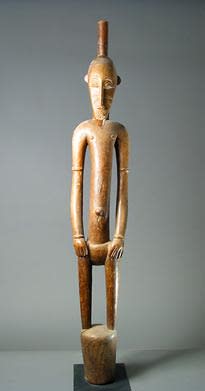Male Senufo Wooden Pombiele Rhythm Pounder, 20th Century CE
Wood
8 x 51.5
PF.4415 (LSO)
Further images
This imposing and elongated sculpture is a pombilele rhythm pounder from the Senufo people of the Ivory Coast and Mali. It is a traditional rendering, but is unusual in being...
This imposing and elongated sculpture is a pombilele rhythm pounder from the Senufo people of the Ivory Coast and Mali. It is a traditional rendering, but is unusual in being a male figure. It stands on a columnar integral base with longer-than-average legs, without feet. The hips are defined as an incised line that delineates the buttocks. The torso is elongated, tapering to the midsection then swelling to the large shoulders. The arms are likewise elongated, the hands resting on the hips. The head is elongated, with a rounded brow and a pointed chin. The nose is long and slim, the lips pursed and the eyebrows arched. The face is scarred with transverse incised marks. The ears and semicircular and plate-like, and the apex of the head is crowned with a vertical pole that was used to carry the piece. Detailing is limited to nipples, umbilicus and bracelets on each wrist and upper arm.
The Senufo group, based in the Ivory Coast and Mali area, has a long history of using highly decorated objects in many aspects of everyday life. However, their extremely high level of skill in woodcarving is nowhere better seen than in the realm of their magical-religious art. At the heart of Senufo society is a patriarchal groups of elders known as the Poro society, which is responsible for many religious and more urbane functions to do with the running of the tribal group. Their ceremonial events are often associated with dancing, music and the use of Pombilele sculptures.
“Pombilele” literally translates as “those who give birth”, and traditionally constitute a pair of figures (one male, one female) who represent primordial humanity and the ancestry of all humankind. Most examples, however, are of single, female figures. The appearance of these figures is relatively homogenous, being tall, slim and somewhat angular. However, the personal characteristics of each sculpture were often based upon a dream or vision by a Poro elder. There is also some social and geographic variability. The figures were used as pounding devices (holding each arm) to keep the rhythm for dancing, or were stood for purposes of contemplation in the middle of the Poro society’s sacred enclosures. They are also used for the interment of prominent Poro members; they are carried to the graveside with the dead body, then used to tamp down the earth on top of the grave, to ensure that the spirit of the dead is directed to the afterlife rather than returning to haunt the living.
This is a striking and attractive piece of African art.
The Senufo group, based in the Ivory Coast and Mali area, has a long history of using highly decorated objects in many aspects of everyday life. However, their extremely high level of skill in woodcarving is nowhere better seen than in the realm of their magical-religious art. At the heart of Senufo society is a patriarchal groups of elders known as the Poro society, which is responsible for many religious and more urbane functions to do with the running of the tribal group. Their ceremonial events are often associated with dancing, music and the use of Pombilele sculptures.
“Pombilele” literally translates as “those who give birth”, and traditionally constitute a pair of figures (one male, one female) who represent primordial humanity and the ancestry of all humankind. Most examples, however, are of single, female figures. The appearance of these figures is relatively homogenous, being tall, slim and somewhat angular. However, the personal characteristics of each sculpture were often based upon a dream or vision by a Poro elder. There is also some social and geographic variability. The figures were used as pounding devices (holding each arm) to keep the rhythm for dancing, or were stood for purposes of contemplation in the middle of the Poro society’s sacred enclosures. They are also used for the interment of prominent Poro members; they are carried to the graveside with the dead body, then used to tamp down the earth on top of the grave, to ensure that the spirit of the dead is directed to the afterlife rather than returning to haunt the living.
This is a striking and attractive piece of African art.





